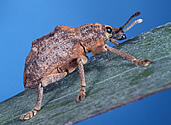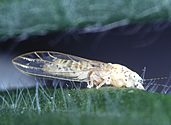| 
Two natural enemies of the invasive melaleuca tree
that have been released in the U.S.: Oxyops vitosa (above) and
Boreioglycaspis melaleucae (below). Click the images for more
information about them.

|
|

|
Foreign Herbivores May Be Key to Curbing Invasive
Weeds
By Alfredo
Flores
June 21, 2007 Joint research with scientists in
Argentina, Australia and China could lead to discovery of new biological
control agents for several exotic weeds plaguing Florida and other U.S. states.
Some of the worst offenders are hydrilla, Brazilian pepper, Chinese tallow and
Australian pine. These and other aggressive invasive weeds occupy diverse
habitats and cause many environmental problems, especially a decrease in
biodiversity within infested areas.
Entomologist
Greg
Wheeler and colleagues at the Agricultural Research Service (ARS)
Invasive
Plant Research Laboratory in Fort Lauderdale, Fla., have been focusing on
this growing problem in the United States. ARS is the
U.S. Department of Agriculture's chief
scientific research agency.
The Fort Lauderdale scientists have been collaborating with counterparts at
the ARS South American
Biological Control Laboratory in Hurlingham, Argentina, and the ARS
Australian Biological Control Laboratory in Indooroopilly, Australia, as well
as with China's Academy of Science.
Together, the researchers are conducting extensive field surveys to discover
herbivorous insects and mites that feed on the invasive weeds in their native
ranges. The researchers have recovered many promising new candidate biological
control agents, including weevil, thrip, psyllid, moth and mite species.
Several are undergoing—or have completed—preliminary testing to
determine their safety for U.S. release.
One, the aquatic moth Paracymoriza vagalis, is a promising hydrilla
biological control agent from Indonesia. Protected from predators in dense
plant material, the moth's larvae can survive submersion for extended periods
while feeding on the weed's underwater portions.
Other potential biocontrols include a South American weevil, Omolabus
piceus, which may be effective against Brazilian pepper, and a possibly
safe and host-specific insect, a leaf-rolling weevil called Apoderus
bicallosicollis, which consumes vast quantities of Chinese tallow leaves.
Wheeler has been invited to report these biological control findings at the
SICONBIOL (Brazilian Society for Biocontrol) in Brasilia, Brazil, June 30-July
4. This year's symposium theme, "Innovate to Preserve Life," will
focus on the development and application of new biological control technologies
and strategies, especially on progress being made in demonstrating the
outstanding potential of certain herbivorous candidates.